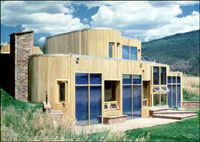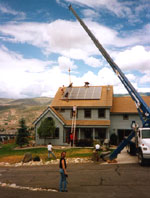Randy Udall charges more for a ton of carbon dioxide than anybody else in the world.
Udall runs a unique, two-and-a-half-year-old program in Aspen and surrounding Pitkin County, Colo., that charges new homeowners up to $100,000 if they exceed the “energy budget” allotted to their property by the local building code. The money collected under the Renewable Energy Mitigation Program is invested by Udall in energy efficiency and renewable-energy projects.
REMP’s goal is to keep three tons of carbon out of the air for every excess ton of carbon spewed on behalf of profligate new homeowners in Aspen. People can still build heated, snow-melting driveways, but they’ll pay the price for it — and on balance, fewer global-warming gases will be released. In the nascent world market of carbon trading, glitzy Aspen has become a pioneer.
“Maybe what we’re doing is a Robin Hood-like approach to environmental problems,” Udall says.
In its first two years, REMP generated $1.5 million, 10 times the revenue administrators expected. That money is administered by the non-profit Community Office for Resource Efficiency, of which Udall (yes, he’s one of those Udalls) is director. Working with city and county elected officials who approve his investments, Udall so far has spent $667,000 on 15 different projects that he calculates will keep 12,000 tons of greenhouse gases out of the air — the equivalent of what is produced by burning 6,000 tons of coal, or enough to power 1,000 average Colorado homes for a year.
HardCORE
The REMP carbon tax is an example of what happens when a progressive community decides to tax bad behavior for good causes — and there’s plenty to tax. During the 1990s, Pitkin County commissioners capped house sizes at 15,000 square feet after the Saudi Arabian ambassador to the United States built himself a 55,000-square-foot vacation bungalow in the area.

Catching rays: an Aspen home with
solar panels.
Photo: Donald Aitken, NREL.
In a place like this, with its spare-no-expense culture, the cost of energy isn’t even on some homeowners’ radar screens. But the environmental impact of energy use is important to elected officials and to many of the town’s residents, who perceive themselves as eco-friendly and forward-thinking.
So in the late 1990s, the city and county adapted a California energy code to the mountains of Colorado. They concluded that a typical Pitkin County house could be well served by an annual energy budget of about 40,000 British thermal units (Btus) per square foot. So that’s how much homeowners got, total. If they wanted a heated driveway or an outdoor swimming pool (major energy sinks at 8,000 feet, but still quite common here), they had to squeeze the juice for it out of the household budget — or from renewable sources, such as a solar hot water heater installed on the site.
Some homeowners simply didn’t want a solar installation, however. “People started suggesting they’d be willing to pay somebody else to put up solar panels, or to get wind power, or whatever it was,” recalls Aspen-Pitkin County chief building official Stephen Kanipe.
REMP was cooked up to allow that to happen. If Kanipe’s staff calculates that a homeowner will go over his or her energy budget, the owner is hit with a one-time fee based on calculations of how much carbon that excess energy demand will dump into the atmosphere over the next 20 years. The calculations assume that if a home is built outside the city limits, 90 percent of the energy will be generated from coal, 10 percent from renewable sources. Inside the city — which buys or produces a lot of local hydropower — those numbers shift to 55-45, meaning a lower tax for home-builders in Aspen proper.

Going solar to avoid the Aspen
taxman.
Photo: Aspen CORE, NREL.
“It’s effectively $340 per ton of carbon dioxide,” says Udall. “It’s the highest carbon tax in the world.”
On top of the steep price (by comparison, carbon currently trades on the world market for between $1 and $2 per ton), the law’s got some additional oomph. If a planned home is 5,000 square feet or larger, the homeowner must install a moderate photovoltaic or solar hot water system, or pay a $5,000 fee. If it’s larger than 10,000 square feet, the system — or the fee — doubles in size.
Cash has come pouring in faster than CORE has been able to spend it. “We had no expectation we’d get this much money,” Udall says. “Spending it wisely is a challenge.” Among the local projects CORE has funded so far:
- Zero-interest loans for homeowners who want to install solar hot water heaters and photovoltaic (PV) panels.
- A cash payment for grid-connected PV systems. “We pay you 25 cents per hour for all the energy you produce for the first four years,” says Udall. This program has produced more grid-connected PV systems (20) in the local electrical co-op than in any other co-op in the nation.
- A solar hot water heater for a local affordable-housing development.
- Installation of a cogeneration turbine at the Aspen community pool and ice rink complex, which will increase the building’s efficiency from 35 to 75 percent.
- A car-sharing program that allows participants the occasional, cheap use of a car when they need it, without actually having to own one.
It’s getting hard for CORE to find worthy local projects. The day I spoke with Udall, he’d just sent $4,000 to a local school, which was going to use it to buy and protect 100 acres of Brazilian rainforest.
Carbon Copies?
Although it’s broadly supported in the communities it serves, REMP’s Robin Hood strategy can be criticized for legitimizing wasteful energy use, allowing the rich in Aspen and Pitkin County to do as they please.
“In another county, it [the tax] might make people think differently,” says Olivia Emery, principal of A4 Architects in nearby Carbondale. “I hate to say it, but in Aspen I don’t think even a $90,000 check means that much if it means you can do what you want.”
Still, Emery says the program is an important one, and has helped put energy questions on the table when property owners think about building a house. “You really have to consider energy from the absolute first thinking about a project,” she says, or the result can be both inefficient and aesthetically unsatisfying.
Not everyone’s happy to just write a check to REMP; Kanipe says that some homeowners, when faced with the dollars-and-cents decision of paying a $60,000 fee or installing and owning a $30,000 solar power system, decide the smart move is to build the system. Either way, the bottom line is that a lot of solar heating and PV projects are being built in the region. Udall estimates 400 solar hot water heating systems are scattered across the Roaring Fork Valley, which encompasses Pitkin County and parts of two neighboring counties.
So far, REMP is a one-of-a-kind program. Kanipe says he has had few inquiries from other communities about how to emulate Aspen’s carbon tax, but would be happy to field them: “I think the same principles would apply no matter where you wanted to regulate energy use.”

